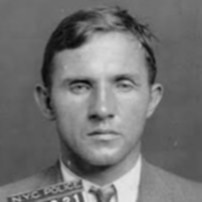
1899 - 1936
Bruno Richard Hauptmann
Summary
Name:
Years Active:
1932Birth:
November 26, 1899Status:
ExecutedClass:
MurdererVictims:
1Method:
Blow to the headDeath:
April 03, 1936Nationality:
Germany
1899 - 1936
Bruno Richard Hauptmann
Summary: Murderer
Name:
Bruno Richard HauptmannStatus:
ExecutedVictims:
1Method:
Blow to the headNationality:
GermanyBirth:
November 26, 1899Death:
April 03, 1936Years Active:
1932Date Convicted:
February 13, 1935bio
Bruno Richard Hauptmann was born on November 26, 1899, in Kamenz, a town near Dresden in the Kingdom of Saxony, which was part of the German Empire. He was the youngest of five children in his family. Interestingly, neither he nor his family used the name Bruno in their daily lives. Instead, during the trial for his later crimes, prosecutors insisted on calling him Bruno.
As a child, Hauptmann was active and joined the Boy Scouts at the age of eleven. He attended public school during the day. At night, he went to trade school to study different skills. He started with carpentry for one year and then switched to machine building for the next two years.
In 1917, Hauptmann faced significant loss when his father died. This difficult time worsened when he learned that two of his brothers, Herman and Max, were killed in World War I. Soon after these tragedies, Hauptmann himself was drafted into the German Army and assigned to an artillery unit.
When he received his orders, he was first sent to Bautzen. After arriving there, he was transferred to the 103rd Infantry Replacement Regiment. In 1918, he was moved to the 12th Machine Gun Company at Königsbrück. Hauptmann later claimed that he served in western France during the war, participating in battles like the Battle of Saint-Mihiel. He also mentioned being gassed and hit by shrapnel, but managed to crawl back to safety.
After the war, Hauptmann, along with a friend, committed a robbery. They stole from two women who were using baby carriages to transport food. Hauptmann's friend brandished Hauptmann's army pistol during this crime. He faced other legal troubles as well, including a burglary at a mayor's home using a ladder. After serving three years in prison, he was arrested again just three months after his release.
In 1923, Hauptmann made the risky choice to immigrate to the United States. He stowed away on an ocean liner and landed in New York City. At 24, he was taken in by a member of the German community and found work as a carpenter. In 1925, he married Anna Schoeffler, a German waitress. They eventually had a child, eight years after their marriage. Hauptmann was known to be very secretive, and his wife did not know his first name was Bruno until he was arrested.
murder story
On March 1, 1932, Charles Lindbergh Jr., the son of famous aviator Charles Lindbergh, was kidnapped from his home in New Jersey. A homemade ladder was found at the scene, suggesting how the abduction happened. A ransom of $50,000 was demanded, and it was delivered by a man named John F. Condon. Sadly, the child’s body was discovered on May 12, buried in woods a few miles from his home. The cause of death was believed to be a blow to the head.
As the ransom money began to circulate, police tracked the serial numbers on the bills. On September 15, 1934, a bank teller recognized one of these serial numbers on a $10 bill deposited by a gas station. The attendant took note of the car's license plate. It matched the one registered to Bruno Richard Hauptmann. This led to him being placed under police surveillance.
On September 19, Hauptmann noticed he was being watched and tried to escape in his car. He was arrested after he crashed into a truck in the Bronx. During his trial, which began on January 3, 1935, evidence was presented linking Hauptmann to the crime. Notable items included a large amount of the ransom money found in his garage and handwriting samples that matched the ransom notes. Witnesses testified that Hauptmann was seen near the Lindbergh home during the kidnapping.
Despite his defense attorney arguing that the evidence was mostly circumstantial, Hauptmann was convicted on February 13, 1935, and sentenced to death. His execution was delayed twice while the governor reviewed the case, but all appeals were denied.
On April 3, 1936, Hauptmann was executed in the electric chair at the New Jersey State Prison. Before his execution, he maintained his innocence and said he was wrongly accused. After his death, his body was cremated, and a small memorial service was held.
In the years that followed, there was significant debate over the evidence and the fairness of Hauptmann's trial. Critics argued that many witnesses were unreliable and that some evidence may have been tampered with. Hauptmann's widow fought for decades to prove his innocence and sought to have the case reopened, citing misconduct by police and prosecution. However, her efforts were ultimately unsuccessful.